Bodinayakkanur
Historical background
Bodinayakkanur, picturesquely sited at the foot hills of Western Ghats in the Theni district, of Tamil Nadu, is a thriving market town where cardamom, coffee, tea, pepper, and silk-cotton are traded.
The zamindars of Bodinayakkanur Palayapattu, whose history goes back to the 14th century, claim to be the descendants of the mythical Kalaikottu Munivar, i.e. Rishyashringa maharishi. They belong to the Rajakambalam Nayakas, a Telugu speaking group who fled from the Bellary region, in present-day Karnataka State, when, in the early 14th century, the troops of Alauddin Khilji invaded that region. They migrated first to western Tami Nadu, then proceeded southwards and eventually settled in the area of Bodinayakkanur.
Read more
In the heart of the town is the palace of the Zamindar of Bodinayakkanur Palayapattu Zamin, built by Bangaru Tirumalai Bodi Nayaka (r. 1849 – 1862). The sprawling building, unfortunately in a sad state of disrepair, houses a generous-sized Darbar hall, the Lakshmi Vilasam, a large room used in bygone days as treasury, a gymnasium, a visitors’ hall, stables for horses and elephants, and a granary. At the death of Bangaru Tirumalai Bodi Nayaka in 1862, his heir Tirumalai Bodaiya Kamaraja Pandya Nayaka was a minor, so the British first took over the administration of the state and, in due course, its territory.
An extensive set of Ramayana paintings, dating of the mid-19th century, adorns the walls of the Lakshmi Vilasam and the Darbar hall. Above each scene is an explanatory caption in colloquial Tamil. The Balakanda narrative, from the beginning up to the departure of the four princely couples from Mithila is ingeniously laid out on the walls of the Lakshmi Vilasam. Particularly interesting are the scenes dealing with the nuptial rituals and the ceremonies, performed according to the Rajakambalam Nayakas traditions. A small shrine in this room houses a painting of the eight-armed family deity of the ruling family, Vadamalai Nachiammannai.
The rest of the narrative is illustrated in great detail on the walls of the Darbar Hall. The rendering of the Parashurama episode followed by the arrival of the newly wed couples in Ayodhya is, strangely enough, the sole episode painted on a portion of the Darbar Hall’s ceiling. Episodes from the Yuddhakanda, such as Indrajit’s sacrifice in Nikumbhila, as well as scenes of music and dance are found on the underside of the lobed arches supporting the hall’s ceiling. Sadly a section of the murals depicting the Yuddhakanda, is lost.
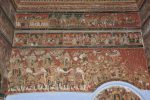
Date: mid-19th century
Description: Top row: King Dasharatha’s party on the way to Mithila; Second row: The arms of the
four princes and their brides to be are massaged with haldi (turmeric); Third row: The four princes on elephants leave Mithila with great pomp, fireworks and crackers.
Location: Tamil Nadu Palace;Bodinayakkanur
Positioning: Lakshmi Vilasam
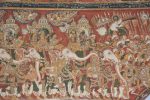
Date: mid-19th century
Description: Rama, Lakshmana and Bharata on elephants surrounded by the festive crowds; Apsaras watch the wedding procession from the sky and strew on it flower petals.
Location: Tamil Nadu Palace;Bodinayakknur
Positioning: Lakshmi Vilasam
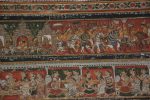
Date: mid-19th century
Description: Top row: Preceded by parasol and insignia-bearers Dasharatha and Vasishtha ride in chariots on their way to Mithila; Second row: Shatrughna, Sita, Urmila and Mandavi’s arms are massaged with haldi (turmeric).
Location: Tamil Nadu Palace;Bodinayakkanur
Positioning: Lakshmi Vilasam
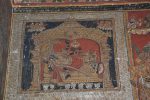
Date: mid-19th century
Description: Vishnu lying on the coils of the serpent Shesha with Bhudevi and Sridevi at his feet, enshrined in the Sri Ranganatha temple on Srirangam Island.
Location: Tamil Nadu Palace;Bodinayakkanur
Positioning: Lakshmi Vilasam
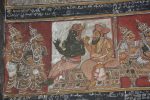
Date: mid-19th century
Description: King Dasharatha washes the feet of Vishvamitra; Vasishtha sits behind the sage, while Sumantra stands behind the King.
Location: Tamil Nadu Palace;Bodinayakkanur
Positioning: Lakshmi Vilasam
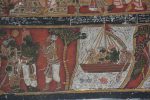
Date: mid-19th century
Description: Vishvamitra talks to a ferryman and along with Rama and Lakshmana is ferried across a river.
Location: Tamil Nadu Palace;Bodinayakkanur
Positioning: Lakshmi Vilasam
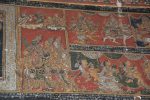
Date: mid-19th century
Description: Scene on the left: The eight dikpalas pay homage to Vishnu; Above them, floating on clouds, are Narada, Tumburu, and flower-strewing gandharvas; On the right, top row: Vishnu, Shiva and Brahma on their vahanas; Bottom row: The queens and their sons.
Location: Tamil Nadu Palace;Bodinayakkanur
Positioning: Lakshmi Vilasam
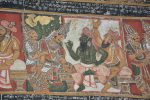
Date: mid-19th century
Description: On hearing Vishvamitra’s request, King Dasharatha faints; His minister, Sumantra, steadies him; Vasishtha, the king’s court chaplain is seated behind Vishvamitra.
Location: Tamil Nadu Palace;Bodinayakkanur
Positioning: Lakshmi Vilasam
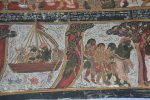
Date: mid-19th century
Description: Vishvamitra and the princes are ferried across the river; The sage, his charges, and yet another disciple perform their ablutions on its banks.
Location: Tamil Nadu Palace;Bodinayakkanur
Positioning: Lakshmi Vilasam
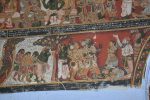
Date: mid-19th century
Description: Vishvamitra, his charges, and yet another disciple perform their ablutions on the bank of the river; Ahalya is freed from her curse when Rama’s foot touches the rock she was transformed into;
Behind her is her husband, the sage Gautama.
Location: Tamil Nadu Palace;Bodinayakkanur
Positioning: Lakshmi Vilasam
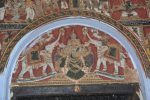
Date: mid-19th century
Description: Arch above the door leading to the puja room, Gajalakshmi.
Location: Tamil Nadu Palace;Bodinayakkanur
Positioning: Lakshmi Vilasam
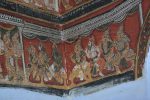
Date: mid-19th century
Description: Vishvamitra, Rama and Lakshmana at the presence of King Janaka, his minister and Shatananda.
Location: Tamil Nadu Palace;Bodinayakkanur
Positioning: Lakshmi Vilasam
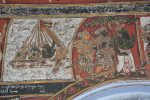
Date: mid-19th century
Description: On their way to the forest, Vishvamitra and the princes are ferried across a river.
Location: Tamil Nadu Palace;Bodinayakkanur
Positioning: Lakshmi Vilasam
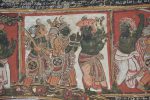
Date: mid-19th century
Description: Vishvamitra prepares Rama and Lakshmana to confront the rakshasi Tataka.
Location: Tamil Nadu Palace;Bodinayakkanur
Positioning: Lakshmi Vilasam
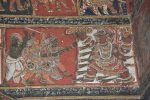
Date: mid-19th century
Description: Rama and Lakshmana fight against the rakshasi Tataka. Vishvamitra looks away.
Location: Tamil Nadu Palace;Bodinayakkanur
Positioning: Lakshmi Vilasam
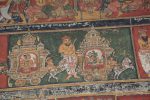
Date: mid-19th century
Description: Vasishtha teaches the princes how to drive a chariot.
Location: Tamil Nadu Palace;Bodinayakkanur
Positioning: Lakshmi Vilasam
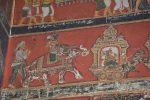
Date: mid-19th century
Description: Rama learns how to ride an elephant and Lakshmana how to drive a chariot.
Location: Tamil Nadu Palace;Bodinayakkanur
Positioning: Lakshmi Vilasam
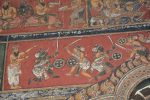
Date: mid-19th century
Description: Vasishtha trains the princes in the art of fencing. On the left: Rama fights against Lakshmana; On the right: Bharata fights against Shatrughna.
Location: Tamil Nadu Palace;Bodinayakkanur
Positioning: Lakshmi Vilasam
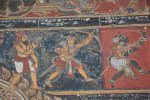
Date: mid-19th century
Description: Vasishtha teaches archery to Shatrughna and Bharata.
Location: Tamil Nadu Palaces;Bodinayakkanur
Positioning: Lakshmi Vilasam
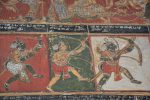
Date: mid-19th century
Description: Bharata, Lakshmana and Rama practise archery.
Location: Tamil Nadu Palace;Bodinayakkanur
Positioning: Lakshmi Vilasam
« Previous 1 2 3 4 5 6 … 11 Next »